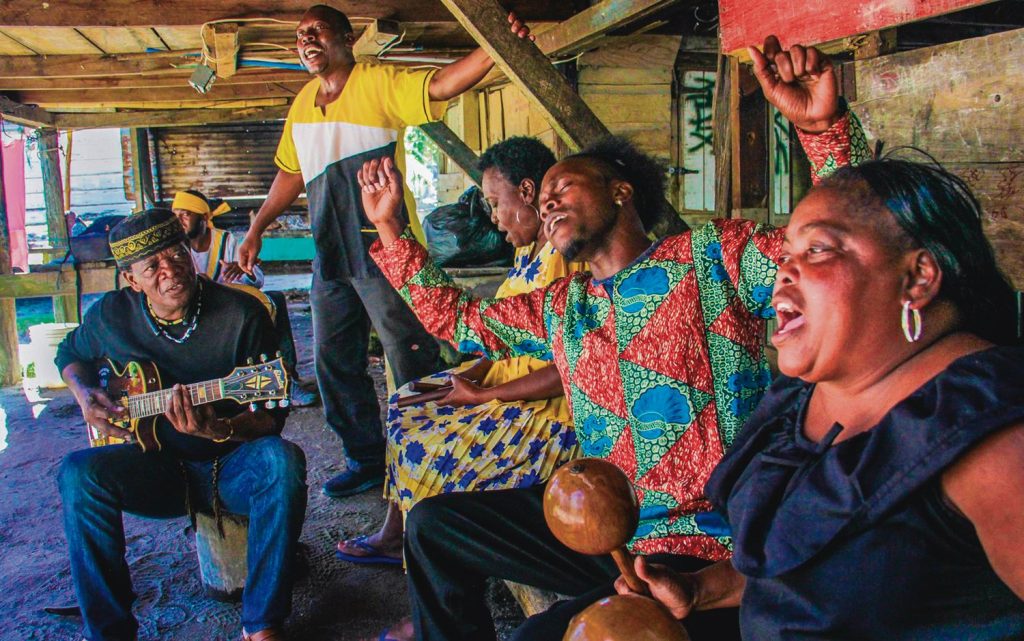The Garifuna Collective is based in Belize and made up of more than 50 musicians of varied generations who strive to express and keep alive the unique music and culture of the Garifuna people.
The Garifuna Collective was featured on Andy Palacios’ album “Wátina” which was awarded the Womex and BBC World Music Award and voted by Amazon as the number one World Music Album of All Time. The Collective just released their newest album, “ABAN,” Sunday (Sept. 15).
Roots and Wires Presents brings the touring arm of the Garifuna Collective to Taos for a show today (Sept. 19) at the Taos Mesa Brewing Mothership, 20 ABC Mesa Road, off U.S. 64 west. The show starts at 8:30 p.m. with doors opening at 8 p.m.
Rooted in resilience and a bit of mystery, the Garifuna people are a mixture of Africans and the original Arawak people of the Caribbean who intermarried four centuries ago. A number of theories exist about their origins and early history.
The music group formed in 2006 and has since traveled to more than 30 countries and five continents sharing their music.

The Garifuna Collective hails from the island nation of Belize.
I caught up with Al Ovando via email to learn more about the Garifuna Collective and what they will be bringing to Taos. Ovando has been a part of the collective since its founding. This is an edited version of our interview.
What are the roles you have with the Garifuna Collective?
My roles include being a musician (guitars and bass), a recording engineer, a mixing engineer and a co-producer in the studio and on the road a tour manager, sound engineer, and rhythm guitarist.
Can you tell me a little bit about the Garifuna people and culture?
The Garifuna people have a long history of resilience and survival. The Garifuna ancestors were brought from the West Coast of Africa to the Lesser Antilles in the Caribbean and intermarried with the native Arawak Indians. They settled on the island of St. Vincent and were eventually exiled and banished from the island by the French and English colonizers. They had a courageous leader called Joseph Chatuye who led them out of harm’s way and they eventually settled on the coast of Nicaragua, Honduras, Guatemala, and Belize. With this movement of people, they brought their own unique language, music, art, food, beliefs, tradition and culture. The Garifuna people live in small, closely bonded villages and towns. They celebrate together in festive times, sad times and in religious ceremonies. This unique way of life is fully accompanied by music. The voices and melodies of men and women can be heard chanting with the deep sounding drums called the Segunda and primero at every opportune time.
What makes Garifuna music unique?
The music is passed down through generations. Each person (composer, singer, instrument player, engineer) is free to play their own original style which comes from the heart of each musician paying homage to their past and keeping it relevant for the future.
What was the vision for the Garifuna Collective – and how has it evolved?
The vision is to create an avenue to keep the tradition and culture alive through documentation and sharing our legacy with the world stage. It has evolved into a group of musicians who understand clearly their role in making the vision a success and in creating a path for future generations to continue the Garifuna story.
How many are in the band?
The Garifuna Collective consists of over 50 musicians and music contributors who have been a part of the project. The touring party is usually eight to nine musicians and this is based on the financial budget before the tour starts.
Can you tell me about your new album, “ABAN?”
The album “ABAN” is the Garifuna Collective venturing into the unknown and experimenting with music and rhythms but keeping true to the soulfulness and unique Garifuna vocal melodies.
What does ABAN mean?
Aban means “one” in English.
Are all of the songs original songs?
All music arrangements are original. All vocals are original except for two songs which are traditional concepts.
Who writes the lyrics for the songs?
Horace Flores, Marcela Aranda, Rolando Sosa, Sheldon Petillo, and Emilio Thomas wrote lyrics on the album “ABAN.”
Who does the musical arrangements?
Ivan Duran, Al Ovando, and Eli Levinson wrote the musical arrangements for “ABAN.”
How did you choose the songs for “ABAN”? Is there an overall theme for the album?
We were experimenting with guitar rhythms and grooves I played. Eli heard them and immediately started to make some drum loops to match. We eventually ended up with melodies that were highly percussive-based and presented it to Ivan in Stonetree Studio. He decided to make use of the work and started working with the vocalist to create melodies over the loops. “Hamala” was created by Emilio Thomas who eventually brought the recorded idea to me and then I took it to the Stonetree Studio where we had fun adding and taking out parts and making the arrangement.
What can people expect from your show here in Taos?
We will take the audience through a historical musical journey as we pay tribute to our friends and ancestors through music. We will play a couple of tracks from the new album “ABAN.”
Anything else you would like us to know?
We are excited to be given a space to share our culture and Belize through music.
By Ariana Kramer
[email protected]
Source: Taos News


